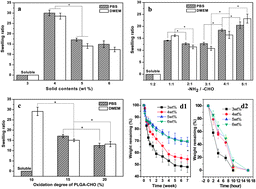Injectable in situ forming poly(l-glutamic acid) hydrogels for cartilage tissue engineering
Abstract
Injectable, in situ forming hydrogels have exhibited many advantages in regenerative medicine. Herein, we present the novel design of poly(L-glutamic acid) injectable hydrogels via the self-crosslinking of adipic dihydrazide (ADH)-modified poly(L-glutamic acid) (PLGA–ADH) and aldehyde-modified poly(L-glutamic acid) (PLGA–CHO), and investigate their potential in cartilage tissue engineering. Both the hydrazide modification degree of PLGA–ADH and oxidation degree of PLGA–CHO can be adjusted by the amount of activators and sodium periodate, respectively. Experiments reveal that the solid content of the hydrogels, –NH2/–CHO molar ratio, and oxidation degree of PLGA–CHO have a great effect on the gelation time, equilibrium swelling, mechanical properties, microscopic morphology, and in vitro degradation of the hydrogels. Encapsulation of rabbit chondrocytes within the hydrogels showed viability of the entrapped cells and cytocompatibility of the injectable hydrogels. A preliminary study exhibits injectability and rapid in vivo gel formation, as well as mechanical stability, cell ingrowth, and ectopic cartilage formation. These results suggest that the PLGA hydrogel has potential as an injectable cell delivery carrier for cartilage regeneration and could serve as a new biomaterial for tissue engineering.


 Please wait while we load your content...
Please wait while we load your content...